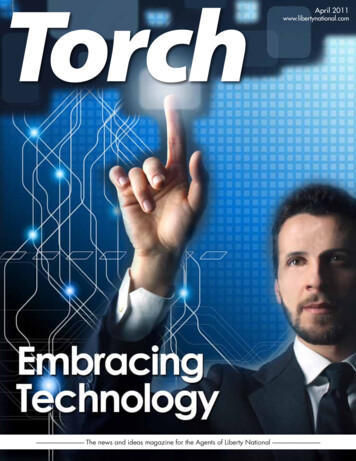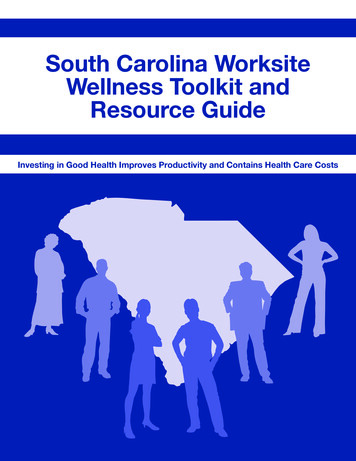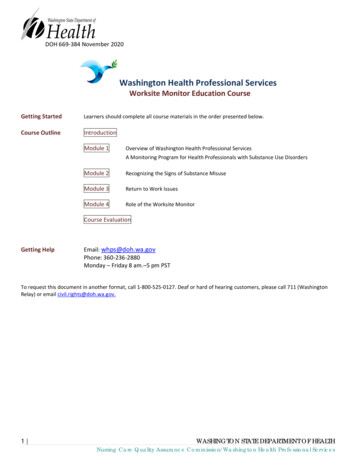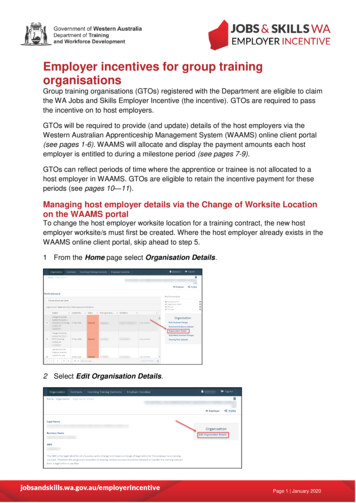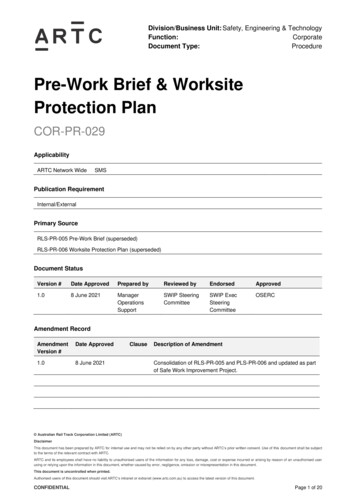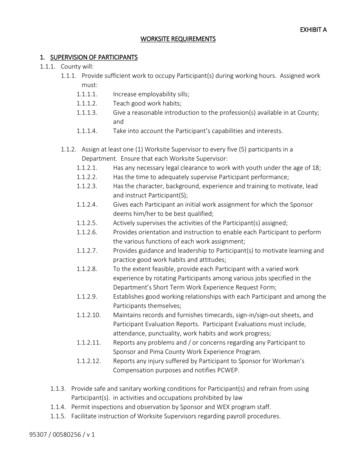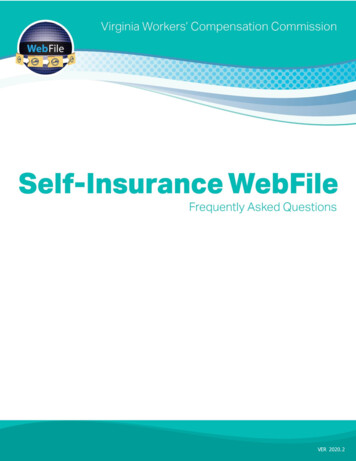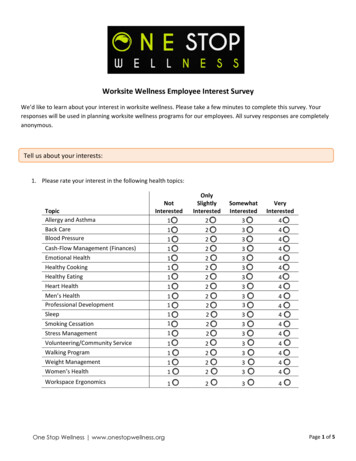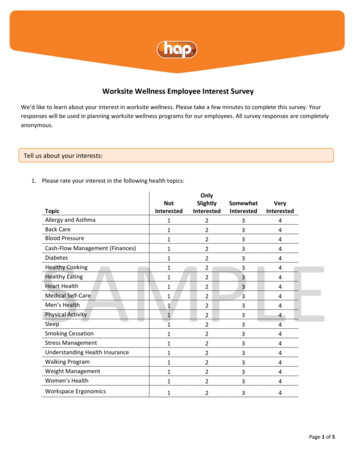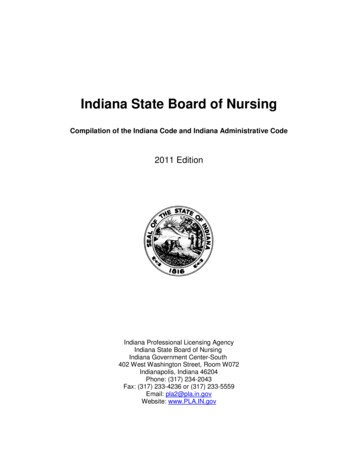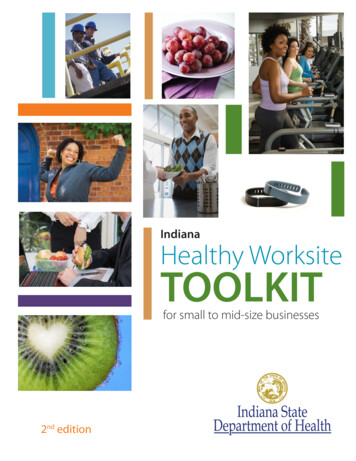
Transcription
IndianaHealthy WorksiteTOOLKITfor small to mid-size businesses2nd edition
Spring 2017Dear Small/Mid-Size Business Partner:The Indiana State Department of Health (ISDH) supports state economic prosperity and quality oflife. Vital to that mission is our goal to improve health behaviors and reduce the incidence ofobesity and chronic disease in Indiana.The topic of wellness has gained national attention in recent years, as obesity numbers continue torise and physical activity decreases. Finding solutions to the nation’s health challenges hasbecome a priority to many, including employers.For the past decade, Indiana has implemented state and local efforts in an attempt to createpositive change in Hoosier wellness. The Indiana Healthy Weight Initiative seeks to create anetwork of collective impact organizations and public health stakeholders that have the capacity tomake policy and create environment change. Additionally, many local entities have prioritizedhealth and wellness initiatives to encourage their communities to thrive.The Indiana State Department of Health believes that a healthy workplace is critical to thepromotion of healthy eating and physical activity. For that purpose, we are providing the IndianaHealthy Worksite Toolkit. We hope this guide encourages your organization to launch policies,support environments and create activities designed to provide your employees with feasiblestrategies to increase wellness opportunities in the workplace.Sincerely,Jerome M. Adams, MD, MPHState Health Commissioner
Table of contentsMaking the healthy choice the easy choice 1Assess your worksite needs 2Employee interest survey 3Workplace assessment 4Vending assessment 10Enhance your worksite environment 12Indiana healthy worksite action plan 13Healthy vending tips 14Healthy meetings and events guidelines 15Menu suggestions for healthy catering 16Promote your efforts 17Promoting stair use 18Promoting use of working walking paths 19Physical activity promotion 19Assessing your efforts 20This publication was supportedby Grant Number 40093945NUPAD16from the Centers for Disease Controland Prevention (CDC). Its contentsare solely the responsibility of the authorsand do not necessarily reflect theofficial views of the CDC, the Departmentof Health and Human Services, orthe federal government.Additional resources 21Tobacco and the worksite 21Chronic disease prevention 22Supporting nursing moms at work 24Acknowledgements 25Action tips 26
Making the healthy choice the easy choiceThe places where we live, learn, work and play influence how we eat and move. No one individual, group, organization,agency or community can create sustainable change alone. However, worksites can play a key role in achieving thisgoal. Focusing on health-related policies and environmental supports where we work is one way to increase access tohealthy foods, promote physical activity and encourage healthier lifestyles for Hoosiers.The strategies in this toolkit follow the objectives outlined in Indiana’s Comprehensive Nutrition and Physical ActivityPlan, 2010-2020, specific to worksites. This plan provides a framework for action across all sectors of Indiana to improvenutrition and increase physical activity.A policy is a written rule or guideline that outlines a course of action applicable to all employees in order to supporthealthier behaviors in the worksite.An environmental support is an effort or strategy (social, physical, or economic) aimed at increasing opportunitiesor reducing barriers for healthy choices within the worksite.IntroductionCreating a culture of health in Indiana small/mid-size businessesAs chronic disease rates and associated healthcare costs increase, Indiana businesses oftentimes shoulder theburden of a sicker and more expensive workforce. Increasing insurance costs, high rates of employee absenteeism,and decreasing productivity can impact the bottom line of businesses of all sizes. In an effort to foster healthieremployees, many employers choose to promote a culture of health and well-being by changing worksite policiesand environment. Although small and mid-size businesses face many challenges in making this culture change, theyalso have a set of unique and exciting opportunities. Supporting healthier employee choices does not have to bedramatic or burdensome to be impactful. In fact, most of the tried and tested strategies provided in this toolkit aredesigned to yield results at little to no cost. Small and mid-size businesses around the state are experiencing thebenefits of being a healthy worksite.Your call-to-actionWorkplaces play a significant role in decreasing Indiana’s high rates of obesity and associated chronic diseases.Employees’ choices and behaviors are influenced by the environment in which they live, learn, work and play. For thisreason, we are calling on employers around Indiana to embrace strategies that provide their workforce with ways to behealthy. This document provides tools, activities, assessments, and ideas to accomplish this goal. A healthy workforce isa healthy community.How to use the Indiana Healthy Worksites Toolkit for Small/Mid-Size BusinessesThis Indiana Healthy Worksites Toolkit for Small/Mid Size Businesses outlines policies, environmental supports andactivities to provide your employees with opportunities to make healthy choices.This guide is divided into five sections:1. Assess your worksite – Identify and determine opportunities for promoting good health at your worksite.2. Enhance your environment – Use strategies and tools to implement policies, environmental supports andactivities at your worksite to provide your employees with opportunities to make healthy choices easier.3. Promote your efforts – Ensure employees are aware of your efforts; create opportunities for employees toparticipate.4. Assess your efforts – Measure the effectiveness of your efforts.5. Additional tools – Additional tools and information you may find useful.Printable versions of each tool will be available on the Indiana Healthy Weight Initiative website atwww.indianaobesity.org.1
Assess your worksite needsAn assessment is an examination of your current overall worksite environment. Assessments can help you understandthe needs and interests of your workforce. Once completed, you can use the results to help identify ways to incorporatephysical activity and healthy eating opportunities at your worksite that align with your organization’s objectives as wellas your employees’ needs and wants.Your assessment can help determine what approach, direction or strategy will work best for your worksite. It will helpdirect your time and resources to the most efficient and effective initiatives. The survey also shows your employeesthat you are listening to their feedback.There are several ways to evaluate your worksite and assess employee needs. Examples surveys include: employeeinterest, worksite environment, and food availability (such as vending machine assessments). Be sure to use theappropriate assessment as these tools evaluate different opportunities for engagement.ToolsEmployee interest survey: This short survey tool is designed to identify employee interests. Surveys introduceemployees to worksite healthinitiatives. It solicits theirinvolvement and approval andplays a significant role in helpingto launch a successful healthinitiative.Workplace assessment: This toolis designed to examine aspectsof your worksite environmentas it relates to supportinghealthy behaviors. Your worksiteenvironment can act as either abarrier or a support for healthyemployee opportunities. Anenvironmental assessment willhelp determine in which categoryyour current worksite fits. It canalso identify areas where you canimprove your worksite to createthose needed supports.Vending assessment: This tool is designed to assess the number of healthier food and beverage choices available inthe vending machines at your business. The more healthy choices available, the more likely your employees will choosethem. You can use the results from this assessment to develop a strategy to increase the availability of healthier choices.2
Employee interest survey directions1. Distribute the employee interest survey to all employees through either paper or online tools.2. Designate a location and date for employees to return surveys anonymously.3. Collect all completed surveys.4. Tally the responses for each question on all surveys.5. The response items with the most checkmarks will give you an indication of your employees’ interests.6. Share the results with employees so that they know their feedback was heard and taken seriously.7. Go to the Enhance your worksite environment section of this toolkit for ideas and strategies on how to addressemployee interests through specific policy and environmental supports.Employee interest survey (example questions)Thank you for completing this survey. Your responses will give us insight into the types of activities that interest you.Participation in this survey is voluntary, and you do not need to respond to any question(s) that you do not wish toanswer. The survey should take about five minutes to complete. We will use the information you provide to incorporatepolicies and environmental supports into our worksite to help support your individual health efforts.1. Which of the following policy supports would be of interest to you if offered at the worksite? (Check all that apply.) Tobacco-free grounds Healthy food/drinks at meetings Flexible work schedule Flexible dress code for physical activity Other Paid time for physical activity Healthy food/drinks in vending machines Not interested in any of the above2. Which of the following environmental supports would be of interest to you if offered at the worksite? (Check all thatwould be of interest.) Changing room Shower facilityCompany garden Discounted gym membershipFarmers market at work Discount at local restaurantsBicycle parking Prompts to take the stairsOther Aerobic/strength training equipmentTobacco cessation assistanceWalking paths around worksiteNot interested in any of the above3. How would you prefer to receive information about employee health activities? (Check one.) Bulletin boards EmailNewsletter Paycheck stufferOtherNot interested in receiving information about health activities Memo4. Are you interested in participating in planning health programs and/or activities? Yes NoIf yes, please provide your name and phone number so that we may follow up (Optional):For a larger employee interest survey, please go ple employee interest survey.pdf3
Workplace assessmentdirections1. Read the entire assessment before you begin.2. Check off all the items that apply to your worksite.3. Walk through your worksite. Talk with employees and ask questions.4. Based on your responses, identify opportunities to enhance your workplace.Carefully examine where policies and supports may be lacking.5. Follow up with leadership and identify opportunities for physical activityand healthy eating in your worksite. The Action cards located with this toolkitcan give you some ideas.6. Evaluate your improvements. Note any differences inemployee productivity and/or activities.7. Schedule assessments for twice a year.4
Workplace assessmentWorkforce characteristics1. Do you have programs to support health and wellness? (see next question for examples) Yes No Unsure Considering2. If yes, what programs do you offer? (check all that apply) Tobacco cessation Physical activity Nutrition Weight management Educational seminars Corporate sponsored team activities Physical activity messages to employees Nutrition messages Social support programs Wellness initiatives that include families 1-800-QUIT-NOW On-site childcare to facilitate participation in wellness activities Other3. Does the worksite have a committee and/or representative that meets at least quarterly to oversee worksite wellnessprograms? Yes No Unsure ConsideringPhysical activity4. Which of the following facilities or offerings are available to employees at your worksites and/or surrounding area?(check all that apply) Changing room Indoor area set aside specifically for exercise Aerobic equipment Fitness classes Accessible/safe stairwells Shower facility Outdoor walking or bike path Strength training equipment Bike storage None Other (please list)5
5. Do your employees participate in physical/manual labor and/or light physical activity as part of their routine work? Yes No Unsure Considering6. Are workstations ergonomically supportive for your employees? Yes No Unsure Considering7. Do your employees have the flexibility to stand at their desks or sit on something other than a standard desk chair(exercise ball, treadmill desk, ergonomic chair, mat, etc.)? Yes No Unsure Considering8. Have you negotiated discounts for employees who wish to exercise at an offsite fitness facility? Yes No Unsure Considering9. Do you provide or subsidize physical assessments, follow-up counseling, and physical activity recommendationseither on-site or through a community exercise facility? Yes No Unsure Considering10. Do you have areas mapped, indoors and/or outdoors, to encourage walking and physical activity at yourworkplace? Yes No Unsure Considering11. Does your worksite have a policy that supports physical activity (walking breaks, extra lunch time to exercise,“fitness” breaks, stretch breaks, flexible schedule)? Yes No Unsure Considering12. Do you have a flexible dress code policy? (ex. employees are permitted to dress casual on day, and a placeto change clothes will be available for employees who’d like to be active during the work day, OR employees arepermitted to wear comfortable walking shoes to support employees being physically active) Yes No Unsure ConsideringNutrition13. Is clean drinking water readily available to employees free of charge? Yes No Unsure Considering14. Does your worksite provide employees with food preparation and storage facilities?(check all that apply) Kitchenette or break room Microwave oven Sink Refrigerator Other15. Through cafeterias, snack bars, vending machines and other purchase points employees have access to:(check all that apply) Sugar-sweetened beverages (regular sodas, fruit juice, lemonade, sweet tea, sports drinks, etc.) Fresh or dried fruits and vegetables Low-fat or low-calorie snacks Alternatives to sugar-sweetened beverages (water, diet drinks, etc.) N/A6
16. If you do offer food on-site, do you: (check all that apply) Subsidize or provide discounts on healthier foods and beverages offered in vending machines, cafeterias,snack bars or other purchase points. Implement or have in place healthier options with signs or symbols. Post guidelines and/or nutrition standards in order to promote healthier food and beverage choices foremployees. N/A17. Does your worksite offer or promote on-site or nearby access to fresh fruits and vegetables (nearbyfarmers market, onsite fruit bowl, produce sharing program)? Yes No Unsure Considering18. Does your worksite have a policy regarding availability of healthy food choices at staff meetings, events, andcelebrations? No Unsure Considering YesHealth norms and values19. Are there employees to support each other in making healthy choices? Yes No Unsure Considering20. Does your leadership actively communicate support for employees’ health and well-being? Yes No Unsure Considering21. Does your organization offer employees paid time to volunteer? No Unsure Considering Yes22. Is your organization involved in any community-wide health initiatives? Yes No Unsure Considering23. Do you have a policy that supports breastfeeding employees? Yes No Unsure Considering24. Do you have a room for breastfeeding employees? Yes No Unsure ConsideringTobacco25. What type of cessation assistance is offered through your health insurance or the workplace? Individual counseling Group counseling Telephone counseling Referral to 1-800-QUIT-NOW Access to medications Behavioral therapies Family therapies Other N/A7
26. Does employer-sponsored health insurance cost less for employees who are nonsmokers? Yes No Unsure Considering27. Do you have a tobacco-free campus policy? Yes No Unsure Considering28. Are there procedures in place to enforce the workplace tobacco use policy? Yes No Unsure Considering29. In your tobacco use policy, do you specify use of e-cigarettes, vapes, etc.? Yes No Unsure ConsideringIncentives30. Do you offer incentives for healthy behaviors? Yes No Unsure Considering31. If yes, what behaviors do you incentivize? (check all that apply): Incentives for healthy eating Participating in regular physical activity Being a current non-user of tobacco Current tobacco users in cessation classes or actively quitting Active commuting to work32. How do you incentivize healthy behaviors? Subsidized memberships for off-site recreation or fitness facilities? Free/subsidized self-management programs for healthy eating and/or physical activity Provide or subsidize physical fitness assessments, follow-up counseling, and physical activityrecommendations on-site or through a facility Sponsor or pay for local fun runs/walks Provide an HSA eligible plan option for employees Other (Please list):8
Health Promotion33. Does the worksite provide on-site child care to facilitate participation in wellness programs and activities? Yes No Unsure Considering34. Do you communicate to employees about wellness program, activities, benefits and other health efforts? Yes No Unsure Considering35. If yes, how do you communicate this information? (check all that apply) Text messages Emails Newsletters Mailings Regular meetings Social media Other N/A36. Are you considering utilization of a benefit plan design to enhance your wellness initiative? Yes No Unsure ConsideringThis tool is meant to be a self-assessment. After you complete it, look back over it and self-assess, choose yourgaps and check for resources pertaining to those HSC lkit with s.pdf9
Vending machine assessment directions1. Take a few moments to read over the assessment toolbefore you begin.2. With a pencil and a clipboard, take a tour of yourworksite.3. Complete the assessment for each vending machine atyour worksite.4. After completing the assessment, review your results:Which category has the largest number of healthieritems? Which category has the least number of healthieritems? Where are the healthier items located?5. Is anything surprising to you? What areas would you liketo improve?10
Healthier choice ItemsNumberof slotsLocation(top, middle, bottom)Labeled ashealthier choice?Comments?SNACK/DRY ITEMS:Baked chipsPlain pretzelsReduced-fat popcornGraham crackersDried fruitNuts, trail mix, seedsGranola bars or whole-grainfruit bars100-calorie packagesCanned or individually packaged fruit (in water or naturaljuice only)Fat-free puddingSugar-free EMS:Light or nonfat yogurtFresh fruit and vegetablesSandwiches made with wholegrain bread and lean meatsNonfat or 1% cottage cheeseSugar-free frozen fruit barsOther:Other:Other:Other:BEVERAGES:Nonfat or 1% milkLow-calorie sports drink100% fruit or vegetable juicePlain or sugar-free flavoredwaterDiet sodaOther:Other:Other:Other:Total number of healthier items available in this machineTotal number of items(Resource: Nutrition Environment Measures Survey - Vending, http://nems-v.com)(Source: Adapted from the Cater to Health Coalition Vending Machine Inventory Tool)11
Enhance your worksite environmentYou can enhance your worksite environment by establishing policies andenvironmental supports that promote healthy activities among employees.Providing these supports can influence employee choices and create a shift to aculture of health.These tools provide many different strategies to help you create a healthierworksite.ToolsAction cards: The Action cards provided with this toolkit outline strategies toenhance the worksite through policy and environmental supports, as well asactivities to support your employees’ individual health efforts.Action plan: This document provides you with the opportunity to identifyimmediate, short-term, and long-term strategies you would like to implementat your worksite. This will be your company’s strategy for enhancing yourenvironment and creating opportunities for healthy choices.Healthy vending tips: This document outlines discussion points for you andyour vending representative to incorporate more healthy choices in your worksitevending machines.Healthy meetings and events guidelines: This document provides healthy food guidelines and opportunitiesto incorporate physical activity into meetings at your worksite. The physical activity examples could also be used foremployees whose duties may not allow for movement for extended periods of time.Menu suggestions for healthy catering: This document includes a menu of recommended foods and beverages forcatered events hosted at your worksite.12
Indiana healthy worksite action planIndividual(s) completing the plan:Date:Overall goal:Short-term goals:(in the next 1-3 months)What do you want to ategies toreach goaldate to becompletedresponsiblepartyIntermediate goals:(in the next 3-6 months)What do you want to ategies toreach goaldate to becompletedresponsiblepartyLong-term goals:(in the next 6-12 months)What do you want to ategies toreach goaldate to becompleted13responsibleparty
HealthyA worksite vending machine often provides one of the fewconvenient sources of food or snacks during the workday.An assessment of vending machine items (on page 11) mayidentify an opportunity to add healthier food and beverageoptions. Focus on increasing the number of healthy,affordable options in vending machines as a policy orenvironmental support. This can create access to healthiereating opportunities for your employees.The following tips may help you add healthier options toyour vending machines.Work with your vending representative on one or more of thefollowing efforts: Rearrange the order of the foods in your machines. Vendors usuallyfollow a standard chart for placing products in the machine. Ask themto place the healthier items at eye level and the less healthy itemstoward the bottom of the machine. Incorporate healthier options into your machines. Use pricing strategies to make the healthier items less expensive.This can be achieved several different ways. Talk with your vendor tosee which approach could work at your location.Start small by incorporating a few healthy options at a time.As employees start to purchase the healthier options, you cangradually increase the number of these items. Conduct surveys or taste tests with employees to helpdetermine which products to stock. Keep in mind that there is often adifference between what people say they will buy and whatthey actually select. Sometimes it is best to try different items in themachine and base decisions on what is purchased. Help your employees make more informed decisions about whatthey purchase. Ask your vendor for the nutrition facts for the foodsand beverages in the vending machines. Ask your vendor to adda sticker, such as an apple, for a quick identification label of ahealthy selection.(Source: National Automatic Merchandising Association)14vendingtips
Healthy meetings and events guidelinesFood guidelinesHealthy food and beverage choices at meetings and other events make it easier for employees to make healthychoices. Food does not have to be the centerpiece of every meeting. However, when appropriate, providing healthierfood options helps to increase opportunities for healthy behaviors. It also sends the message that management valuesthe health of its employees.Consider offering healthy foods at meetings, celebrations, potlucks and formal business receptions. Begin by addinghealthier options and gradually reducing less healthy foods and beverages. You may want to create a company policythat allows offering food and/or snacks only at meetings that occur during a mealtime.Food-service vendors are familiar with healthier food preparation options and most are willing to accommodaterequests for changes to their usual fare. General guidelines for selecting healthier food and beverage options formeetings include: Serve low-calorie, low-fat foods. Serve fruits and vegetables whenever possible. Serve small portions (e.g., cut bagels in half ). Serve low- or nonfat milk (1% or skim), 100% fruit or vegetable juice,water, unsweetened hot or iced tea or diet soda. Include a vegetarian option at all meals. Serve salads with dressing on the side—offer at least one low-fat orfat-free dressing. Provide pitchers of water. Provide some whole-grain breads and cereals. If serving a dessert, provide fresh fruit, fruit crisps, small cookies or small servings of sorbet.(Source: New York State Department of Health, Guidelines for Healthy Meetings)Physical activity guidelinesProviding physical activity breaks at meetings and events can help participants remain alert and focused. Physical activitybreaks re-energize participants during meetings, especially those lasting longer than one hour. Physical activity breaksthat last 10-15 minutes provide a great opportunity for employees to get part of their recommended daily 30 minutes ofmoderate physical activity. Here are some suggestions on how to incorporate physical activity into meetings: Choose a meeting location where participants can safely take a walk during designated break periods. Provideattendees with maps of the area. Ensure that the walking route has walkways with ample width and curb cuts, sopeople who use mobility devices can participate. Consider a casual dress code for the meeting—this allows people to participate in physical activities more easily.Notify attendees in advance about physical activity breaks, so they can dress appropriately. Organize physical activity breaks that can be modified or adapted for people of all abilities, such as stretchingexercises that can be done in a seated position. Encourage participants to take the stairs. Place signs near the elevators telling people where the stairs are located. Schedule brief activity breaks in the morning and afternoon (e.g., walking in place, stretching). Use icebreakers that encourage people to move around the room. Incorporate a walk-and-talk session into the meeting agenda by encouraging participants to go for short walkswhile they discuss agenda items.(Sources: New York State Department of Health, Guidelines for Healthy Meetings; California Department of PublicHealth., Physical Activity at Meetings.)15
MENU SUGGESTIONS FOR HEALTHY CATERINGBeveragesWater100% fruit or vegetable juices—no larger than 12 oz. portionsSkim or 1% milkCoffee, regular and decaffeinatedTea—regular and herbal teas—hot or cold, unsweetenedBreakfastFresh fruitHigh-fiber cerealsFruit toppings for hot and cold cerealsHard-boiled eggsVegetable omelets or eggs made with egg substitute or egg whitesLow-fat yogurtThinly sliced hamBagels (cut in half ) served with fruit spreads, jams, hummus or low-fat cream cheeseMuffins—small or mini (5g fat or less/muffin)Fruit bread (5g fat or less/1-oz slice)Granola bars—low-fat (5g fat or less/bar)SnacksFresh sliced fruit and vegetable tray, offered with low-fat dipsWhole-grain crackers or granola bars (5g fat or less per serving)An assortment of low-fat cheeses and whole-grain crackersBaked pita chips served with hummusLow-fat yogurtPretzels, served with mustard dipTortilla chips, baked and offered with salsa dipPopcorn, lower-fat (5g fat or less/serving)Whole-grain crackers (5g fat or less/serving)Lunch &DinnerSalad that includes a variety of mixed salad greens and served with low-fat dressing (on the side)Whole-grain breads and rollsMustard and low-fat mayonnaise as condiments for sandwichesSandwiches presented in halves, so people can take a smaller portionBroth-based soups (using a vegetarian broth) instead of cream-based soupsPasta dishes with tomato or other vegetable-based sauces4-ounce maximum portions of meatRaw or steamed vegetables(Source: EAT SMART NORTH CAROLINA: Guidelines for Healthy Foods and Beverages at Meetings, Gatherings, and Events)16
Promote your effortsPromoting your worksite health efforts plays an important role in whether or not your employees take advantage ofthe opportunities you are creating. Once these strategies are in place, it is important to educate your employees aboutthe changes so they know healthier options are available.There are several ways to promote your efforts. You will need to determine the best way to communicate with youremployees based on your business’s culture. Some ways to communicate with your employees about worksiteinitiatives include: Provide information to employees during meetings. Create flyers, brochures or posters to display aroundthe worksite. Post announcements on your organization’sIntranet page. Send email updates to your employees. Create a (weekly, biweekly, monthly, bimonthly,quarterly) employee newsletter or add updates to anexisting employee newsletter. Post updates on worksite bulletin boards.Be creative! These changes can be fun and exciting
Assess your worksite - Identify and determine opportunities for promoting good health at your worksite. 2. Enhance your environment - Use strategies and tools to implement policies, environmental supports and activities at your worksite to provide your employees with opportunities to make healthy choices easier. 3.
